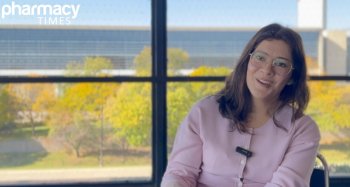
Pearl 1: The Use of Co-Pay Cards to Solve an Economic Burden
Peter Salgo, MD: I knew you were going to say that. But does this affect the way these drugs get prescribed? I mean are there physicians who simply say, “You can’t afford these drugs?”
Noa Biran, MD: Absolutely.
Peter Salgo, MD: We’ve got to stay with Medicare Part B, not Part D?
Noa Biran, MD: Absolutely. We have a lot of patients where their co-pay, even though it might be 10%, 10% of $10,000 is a whole lot of money every single month.
Peter Salgo, MD: It is.
Noa Biran, MD: So oftentimes we’ll look for grants. We have a full-time person who spends all her time looking for grants, and most of the time they make a little bit too much money to meet the cutoff, and they still can’t afford it and we have to change plans.
Peter Salgo, MD: What is a co-pay card? I keep hearing this.
Cheryl Allen, BPharm, MBA: That’s a commercial co-pay card.
Peter Salgo, MD: What’s that?
Cheryl Allen, BPharm, MBA: The way that a manufacturer can help support the patient’s out-of-pocket expense is through a commercial co-pay card that is only eligible for commercially insured patients.
Peter Salgo, MD: All right, I’m getting confused again. Is this from the manufacturer?
Cheryl Allen, BPharm, MBA: It is from the manufacturer.
Peter Salgo, MD: And this co-pay card helps defray the cost for?
Cheryl Allen, BPharm, MBA: For commercially insured. So government insured, Medicare and Medicaid.
Noa Biran, MD: That doesn’t sound legal.
Cheryl Allen, BPharm, MBA: Well in fact, it’s illegal to use these cards in the government-insured population. So CMS [Centers for Medicare & Medicaid Services] doesn’t allow the use.
Peter Salgo, MD: This is just craziness.
Noa Biran, MD: Crazy, yes.
Peter Salgo, MD: I’m so glad you used that word because it’s one of my favorite words.
Cheryl Allen, BPharm, MBA: Well some commercial payers even have taken a stance against the use of co-pay cards.
Peter Salgo, MD: What’s the problem with the co-pay cards?
Noa Biran, MD: It’s a conflict of interest.
Peter Salgo, MD: Why?
Noa Biran, MD: Because the company, the manufacturer, is basically saying: “You don’t have to pay your co-pay,” to the patient. In a doctor’s office we are physically not allowed to absolve a patient of their co-pay, because the decision of the treatment needs to be in hands of the patient.
Peter Salgo, MD: I was going to say this.
Noa Biran, MD: And the patients need to be able to determine what they do and do not want to receive. And cost needs to play a factor in that.
Peter Salgo, MD: Let me ask a very basic question that just occurred to me. If a manufacturer can afford to provide you with a co-pay card, couldn’t that manufacturer just lower the cost of the drug overall?
Noa Biran, MD: Thank you.
Peter Salgo, MD: You’re welcome.
Cheryl Allen, BPharm, MBA: Well, this entire pricing scenario is being discussed in Washington and we’ve got a grand plan and we’re looking at an international pricing index. Suffice it to say that the research and development for all of the drug products for the most part, the technology is from here in the United States. So our research is supporting drugs that are curing disease and helping patients live with chronic disease, over the entire world.
Peter Salgo, MD: I understand that. To some degree we’re paying a lot.
Cheryl Allen, BPharm, MBA: Our system is built on drug prices, price rebates, all of this factors in. There’s the payer, there’s the PBM [pharmacy benefit manager]. We can’t pull out one segment of that and expect it all just magically to work. It is frustrating that the drug prices are very high for our patients, and one way that manufacturers have found the ability to help patients, as they can, is through co-pay offset. So in the commercial space, it is a co-pay card. Now for patients who can’t use those, the government-insured patients, there are 501(c)(3) foundations. So the groups that you spoke of. This is generally available to patients based on an economic need, a percentage of federal poverty level.
Peter Salgo, MD: But again, that’s at least across the board, and it’s not for a particular product, right?
Cheryl Allen, BPharm, MBA: It’s not, it’s based on disease state.
Peter Salgo, MD: Right, it’s based on disease state and economic need.
Cheryl Allen, BPharm, MBA: Right.
Peter Salgo, MD: Which I would guess you like better.
Noa Biran, MD: Yes. Although it’s not.
Peter Salgo, MD: Although what?
Noa Biran, MD: It’s not entirely solving the problem.
Peter Salgo, MD: Nothing can entirely solve the problem, right?
Noa Biran, MD: Right, not even close. And even these funds are running out.
Cheryl Allen, BPharm, MBA: They’re running out. There’s been a great deal of scrutiny around the 501(c)(3) funds, and manufacturers have looked at those, and the OIG [Office of Inspector General] rulings around those, and we’re seeing a couple of things. The funds aren’t there…or lack of funds going in, decreased funds, and then secondly, there are more people trying to use these funds, right? So at our organization, 2006 was the first time we started looking at these types of funds. And we had half of a resource dedicated then. Today we have 22 people, full time, working on foundation support across all of our business, but a large percentage is oncology.
Peter Salgo, MD: I don’t want to belabor this, and I do want to move on, but can you make the case that this is a chronic disease? We’re now talking about people who are living not 3, 5, 8 years, but 10, 20, 30 years. They’re in the workforce, they’re productive, they’re paying taxes. So to some degree they’re paying in, in tax money, what they should be getting out, at least in part, from the government to pay for this.
Noa Biran, MD: Yes, although the majority of the patients are, the median age is 70. So most patients are not working. Maybe more are than they were.
Peter Salgo, MD: Seventy is the new 40, or haven’t you heard? I mean people are living longer, they’re healthier.
Noa Biran, MD: Yes, oh I know.
Peter Salgo, MD: Right. So maybe that’s where it’s adjustable.
Noa Biran, MD: They’re not coming in for infusions.
Cheryl Allen, BPharm, MBA: And the 70-year-old spent 40 years working somewhere paying into a benefit that now they’re being told, “Well, you know, your out-of-pocket is $2,000, just to get started.”
Peter Salgo, MD: Right.
Noa Biran, MD: Right.
Newsletter
Stay informed on drug updates, treatment guidelines, and pharmacy practice trends—subscribe to Pharmacy Times for weekly clinical insights.























































































































































































































